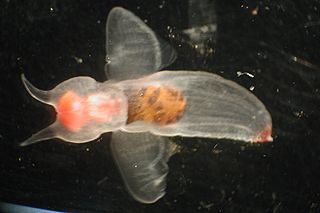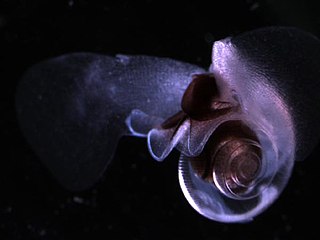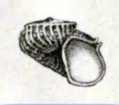
Sea butterflies, scientific name Thecosomata, are a taxonomic suborder of small pelagic swimming sea snails. These are holoplanktonic opisthobranch gastropod mollusks in the informal group Opisthobranchia. They include some of the world's most abundant gastropod species.

Sea angels are a large group of extremely small, swimming sea slugs, not to be confused with Cnidarians, classified into six different families. They are pelagic opisthobranchs in the clade Gymnosomata within the larger mollusc clade Heterobranchia. Sea angels were previously referred to as a type of pteropod.

Sea slug is a common name for some marine invertebrates with varying levels of resemblance to terrestrial slugs. Most creatures known as sea slugs are actually gastropods, i.e. they are sea snails that over evolutionary time have either completely lost their shells, or have seemingly lost their shells due to having a greatly reduced or internal shell. The name "sea slug" is most often applied to nudibranchs, as well as to a paraphyletic set of other marine gastropods without obvious shells.

Opisthobranchs is now an informal name for a large and diverse group of specialized complex gastropods which used to be united in the subclass Opisthobranchia. That taxon is no longer considered to represent a monophyletic grouping.

Limacina is a genus of swimming predatory sea snails commonly known as sea butterflies in the family Limacinidae. This genus contains some of the world's most abundant gastropod species.

Cymbuliidae is a family of pelagic sea snails or "sea butterflies", marine gastropod mollusks in the superfamily Cymbulioidea.
Desmopteridae is a family of pelagic sea snails or "sea butterflies", marine gastropod mollusks in the superfamily Cymbulioidea.
The Notobranchaeidae, or "naked sea butterflies", are a taxonomic family of floating sea slugs, specifically under the subclass Opistobranchia, also called "sea angels".

Clione is a genus of small floating sea slugs, pelagic marine gastropod mollusks in the family Clionidae, the sea angels.

Pteropoda are specialized free-swimming pelagic sea snails and sea slugs, marine opisthobranch gastropods. Most live in top 10 m of the ocean and are less than 1 cm long. The monophyly of Pteropoda is the subject of a lengthy debate; they have even been considered as paraphyletic with respect to cephalopods. Current consensus, guided by molecular studies, leans towards interpreting the group as monophyletic.

Sea snail is a common name for slow moving marine gastropod molluscs usually with visible external shells, such as whelk or abalone. They share the taxonomic class Gastropoda with slugs, which are distinguished from snails primarily by the absence of a visible shell.

Neritoidea is a taxonomic superfamily of mostly sea snails, nerites and their allies, marine gastropod mollusks in the order Cycloneritida.
Peraclidae is a family of pelagic sea snails or "sea butterflies", marine gastropod mollusks in the superfamily Cymbulioidea.

Pyramidelloidea is a superfamily of mostly very small sea snails, marine gastropod mollusks and micromollusks within the clade Panpulmonata.

Vetigastropoda is a major taxonomic group of sea snails, marine gastropod mollusks that form a very ancient lineage. Taxonomically the Vetigastropoda are sometimes treated as an order, although they are treated as an unranked clade in Bouchet and Rocroi, 2005.

The Pterotracheoidea is, according to the Taxonomy of the Gastropoda, a taxonomic superfamily of sea snails or sea slugs, marine gastropod molluscs in the clade Littorinimorpha. They are commonly called heteropods or sea elephants.

Scissurelloidea is a taxonomic superfamily of minute sea snails, marine gastropod mollusks or micromollusks in the clade Vetigastropoda.

Cymbulioidea is a taxonomic superfamily of pelagic "sea butterflies", one group of swimming sea snails. They are holoplanktonic opisthobranch gastropod molluscs in the clade Thecosomata.

Hydromyloidea is a taxonomic superfamily of sea slugs, specifically sea angels, marine opisthobranch gastropod mollusks in the order Gymnosomata.

Clione limacina, known as the naked sea butterfly, sea angel, and common clione, is a sea angel found from the surface to greater than 500 m (1,600 ft) depth. It lives in the Arctic Ocean and cold regions of the North Atlantic Ocean. It was first described by Friderich Martens in 1676 and became the first gymnosomatous "pteropod" to be described.













